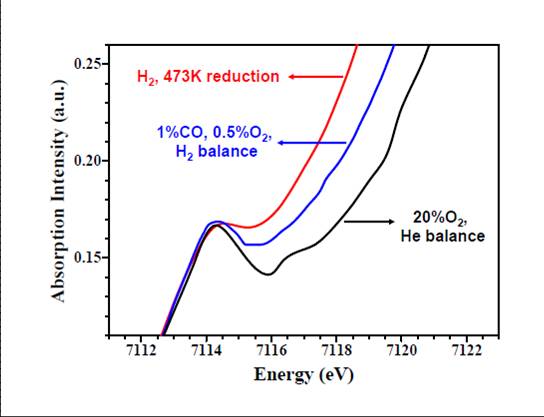






The SSRF XAFS Beamline (BL14W1) user work was published on Science Magazine
The research group of Prof. Xinhe Bao, an academician of the Chinese Academy of Sciences, from Dalian Institute of Chemical Physics, Chinese Academy of Sciences, found a new general principle for designing new types of metal oxide catalyst that used in fuel cells and other industrial applications. Through the close cooperation with the research group of Prof. Yuying Huang, head of the XAFS(X-ray Absorption Fine Spectroscopy) beamline (BL14W1) at Shanghai Synchrotron Radiation Facility (SSRF), they performed the in-situ XAFS experiment for this nano catalyst and proved the presence of ferrous species under the working conditions. This result was recently published on Science (2010, 328, 1141), and reported by C&E News and Chemistry World.
Coordinative unsaturated ferrous (CUF) sites confined in nano sized matrices are active centers in a wide range of enzyme and homogeneous catalytic reactions. Preparation of the analogous active sites at supported catalysts is of great importance in heterogeneous catalysis but remains a challenge. On the basis of surface science measurements and density functional calculations, they show that the interface confinement effect can be used to stabilize the CUF sites by taking advantage of strong adhesion between ferrous oxides and metal substrates. The interface-confined CUF sites together with the metal supports are active for dioxygen activation, producing reactive dissociated oxygen atoms. They show that the structural ensemble was highly efficient for carbon monoxide oxidation at low temperature under typical operating conditions of a proton-exchange membrane fuel cell.
The structure and dynamic investigation under the working conditions is very important to clarify the catalysis theory. SSRF is a third-generation synchrotron radiation light source, and is invaluable tools for catalysis research. X-ray absorption fine spectroscopy (XAFS) is an important technique for the investigation of the atomic and electronic structure of catalyst. This technique is very effective to understand the structure of the multi-composition, multi-system catalyst. The SSRF BL14W1 beamline is a general purpose XAFS beamline. The source of BL14W1 is a 38-pole wiggler device. The XAFS experiments can be performed with high energy resolution, high spectrum purify, high ratio of signal / noise and low content analysis.
As the large-scale scientific facility for science research and technology development in China, more than hundreds of scientists and engineers from universities, institutes and industries in domestic and even overseas can do their research, experiments and R&D by using SSRF each day. The SSRF-BL14W1 beamline will provide a good research platform to scientists in catalyst.


In-situ Fe K-edge X-ray absorption (XANES) spectra from the Pt-Fe/SiO2 catalysts after exposure to various reaction gases measured at Shanghai Synchrotron Radiation Facility (SSRF)